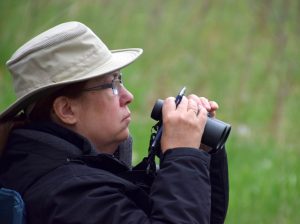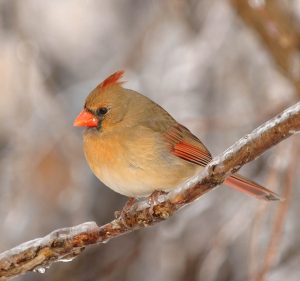Illinois Master Naturalists involved with citizen science programs
University of Illinois Extension Services — April 17, 2022
Extension Master Naturalist Mary Zehner is an avid bird watcher. She is also a Citizen Scientist. Local EMNs participate in several different Citizen Scientist programs including Mary’s favorite The Cornell Lab of Ornithology eBird program. She has contributed 1,454 checklists within a 15-mile radius of her home. (Photo courtesy of University of Illinois Extension)
Volunteer efforts can lead University of Illinois Extension Master Naturalists (EMN) on some fun adventures. Sometimes those adventures are as close as their backyard. Citizen Science programs have given EMNs serving in Fulton, Mason, Peoria, and Tazewell counties opportunities to use their skills and knowledge to impact their communities and beyond.
“I believe the Master Naturalist program has its greatest value in the knowledgeable volunteers who assist professional agencies and organizations that work on environmental issues,” stated EMN Marcia Heitz. Local EMNs have been providing their expertise to Audubon Society Christmas Bird Count, BeeSpotter, Bumble Bee Watch, FrogWatch USA, CoCoRaHS, Great Backyard Bird Count, Great Sunflower Project, Illinois RiverWatch, iNaturalist, Monarch Watch, Monitoring of Owls and Nightjars, and Project Squirrel.
Citizen Science programs are often described as public participation in scientific research. It is also known as community science, crowd science, and volunteer monitoring. According to the Wikipedia definition, citizen science improves the scientific community’s capacity as well as increase the public’s understanding of science.
With the extensive training EMNs receive, along with their own personal education and professional backgrounds, EMNs are the perfect volunteers for citizen science programs. It also is a perfect way for EMNs to fit in volunteer hours in their busy schedules.
Kate MacIntrye shared, “Citizen Science is a great way to still help in some way, but on my own time and schedule. My background is in Biology, so it is a way for me to still collect data and see interesting results based on many other Citizen Scientists all over the world!”
Other “perks” that EMNs describe about their Citizen Scientist experiences include the ease of using the technology to submit data, the continuing education as they improve their record keeping skills and more about their area of science, and the impact they are making to help locally and nationally.
Through the Cornell Lab of Ornithology, MacIntrye is actively involved in Project FeederWatch, NestWatch and eBird. “They have great platforms for adding data through your computer or an app on your phone, which makes it easy to participate whenever and wherever you might be at the time! It offers anyone the opportunity to learn something new, while helping scientists collect important data, where there is usually not enough funding to hire staff to do it. It is a win-win.”
“Since I became an EMN, I’ve been keeping regular eBird lists using the app on my phone. So far, I’ve contributed 1,454 checklists,” Mary Zehner reported. “Using eBird pushes me to identify every bird vs. just what is unusual, so my field skills with more common birds have improved. The need for field notes in the app has improved my old-fashioned naturalist skills of observing and describing birds in the field thoroughly and accurately with appropriate terminology.
“The regular practice makes it easier to keep a list efficiently for events such as Christmas Bird Count or Spring Bird Census. My reports help other birders, both locally and from farther away, know where and when to find species of interest. Keeping lists in our 15-mile diameter circle (centered on our home) has helped me appreciate diverse habitats in our immediate area.”

Some University of Illinois Extension master naturalists participate in the Cornell Lab of Ornithology’s Project FeederWatch, which involves putting out bird feeders and counting backyard birds during the winter. (Photo courtesy of Cornell Lab)
EMN Dina Petit started her own bluebird route in Pekin’s McNaughton Park, and wanted to share the data through NestWatch, so it would be available for organizations tracking the species,” Petit shared. “It is a great way to contribute to the scientific community on your own time. The projects also provide lots of valuable information and training to those who want to participate.”
“I have a fascination with weather so I looked into Community Collaborative Rain, Hail, & Snow Network (CoCoRaHS),” explained EMN Carla Presnell. “I was surprised to see that there were only two people in Fulton County reporting data. I felt my county needed more representation. I love tracking weather, and this was an easy but vital way of getting volunteer hours. The first time I saw a Peoria meteorologist’s report show the precipitation amount I had submitted earlier in the day for Canton, I was so excited! it made me feel like I was part of the bigger picture and by doing something so simple I could help supply data to professionals relying on that data to track patterns and trends.”
“I enjoy doing citizen science projects that are research based,” Heitz added. “These include statewide projects like Riverwatch, the Monarch projects, monitoring nightjars along specific routes & photographing bumble bees and submitting them for identification in order to determine which species are located in what areas. I also enjoy projects that are not just local but can involve several states such as the woodcock breeding survey for the University of Arkansas. I believe that without the assistance of citizen science the agencies heading up these projects would be undermanned and the projects would be cost prohibitive.”
To find a citizen science project which suits your interest visit, the Illinois Department of Natural Resources Citizen Science projects at www2.illinois.gov/dnr/education/Pages/CitizenScience.aspx. If you are looking for a broader reach visit CitizenScience.gov at www.citizenscience.gov/






